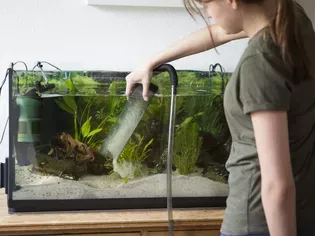Should You Vacuum Your Aquarium Gravel?
Updated on 04/26/24

Should You Vacuum Your Aquarium Gravel? A Comprehensive Guide for Sparkling Clean Aquariums
Maintaining a pristine aquarium requires a delicate balance of cleaning and preserving the delicate ecosystem within. Among the many aspects of aquarium maintenance, the question of whether or not to vacuum the gravel often arises. While it may seem like a straightforward task, there are several factors to consider before you set your sights on your aquarium gravel. This comprehensive guide will delve into the pros and cons of vacuuming aquarium gravel, providing you with the knowledge and insights to make an informed decision for your underwater sanctuary.
Understanding the Aquarium Ecosystem
Before delving into the specifics of gravel vacuuming, it is crucial to gain a deeper understanding of the intricate ecosystem that exists within your aquarium. Aquarium gravel serves as a vital component of this ecosystem, providing habitat for beneficial bacteria, which play a significant role in the nitrogen cycle. These bacteria convert toxic ammonia and nitrite into less harmful nitrate, maintaining a healthy environment for your fish.
Additionally, the gravel provides a surface for plants to anchor themselves, contributing to a lush and aesthetically pleasing underwater landscape. Vacuuming the gravel too frequently can disrupt this delicate balance, potentially harming the beneficial bacteria and disturbing plant roots.
Pros of Vacuuming Aquarium Gravel:
* Waste Removal: Vacuuming the gravel effectively removes organic waste, such as uneaten food, fish waste, and decaying plant matter, which can accumulate over time. By removing this waste, you prevent the buildup of ammonia and nitrite, maintaining water quality and reducing its impact on aquatic life.
* Aesthetics: A well-vacuumed gravel bed adds to the overall visual appeal of your aquarium. Removing debris and dirt from the gravel enhances the clarity of the water column, showcasing your fish and plants in their vibrant glory.
* Oxygenation: Vacuuming the gravel can help improve oxygenation by removing organic matter that would otherwise decompose and consume dissolved oxygen. This is especially beneficial for species that require higher oxygen levels, such as certain types of fish.
Cons of Vacuuming Aquarium Gravel:
* Disruption of Beneficial Bacteria: As mentioned earlier, vacuuming the gravel can disrupt the growth of beneficial bacteria that reside in the gravel bed. Overzealous gravel vacuuming can reduce the population of these bacteria, impairing the efficiency of the nitrogen cycle.
* Plant Disturbance: Vacuuming the gravel can unintentionally disturb plant roots, especially if the gravel is deep. This can lead to stunted growth, wilting, or even the death of some plants.
* Nutrient Depletion: Vacuuming the gravel can remove essential nutrients that are stored in the substrate. These nutrients are beneficial for plants and can aid in maintaining a healthy ecosystem.
When to Vacuum Aquarium Gravel:
The frequency of gravel vacuuming should be based on several factors, including the size of your aquarium, the number of fish you have, and the type of filtration system you are using. As a general guideline, here are some recommendations:
* Light to Medium Stocking: 1-2 times per month
* Heavy Stocking: 2-3 times per month
* Aquariums with Undergravel Filters: Once every 2-3 months
* Aquariums with Canister or HOB Filters: Once every 1-2 months
How to Vacuum Aquarium Gravel:
To minimize the potential risks associated with gravel vacuuming, it is essential to follow the proper technique:
* Use a Gravel Vacuum: Invest in a dedicated gravel vacuum specifically designed for aquarium use. These vacuums have a specially designed nozzle that allows you to effectively remove debris from the gravel without sucking up small fish or shrimp.
* Partial Gravel Vacuuming: Instead of vacuuming the entire gravel bed at once, focus on removing only 20-30% of the surface gravel during each cleaning session. This approach helps preserve beneficial bacteria populations.
* Rinse the Gravel Vacuum: After each use, thoroughly rinse the gravel vacuum with clean water to remove any debris or waste particles. This prevents cross-contamination between different parts of your aquarium.
Alternatives to Gravel Vacuuming:
If you are concerned about the potential drawbacks of vacuuming aquarium gravel, consider the following alternative methods for removing waste:
* Turkey Baster Method: Use a turkey baster to spot-clean specific areas of the gravel bed, removing debris and waste without disrupting the entire substrate.
* Airlift Sponge Filter: An airlift sponge filter can gently remove fine particles from the water column, effectively reducing the amount of waste that settles on the gravel.
* Python Water Changer: A Python water changer allows you to simultaneously remove water and vacuum the gravel, reducing the risk of disturbing the beneficial bacteria.
Conclusion:
The decision of whether or not to vacuum your aquarium gravel is not a simple one. While vacuuming can effectively remove waste and improve water quality, it can also disrupt the delicate ecosystem within your aquarium. By carefully considering the pros and cons and adopting a responsible approach to gravel maintenance, you can strike a balance between maintaining a pristine environment and preserving the health of your underwater inhabitants.
Explore More Pets

Freshwater Aquarium Filters
How to Deal With Cloudy Aquarium Water

Saltwater Aquarium Filters
How Do You Remove Chloramines From Tap Water?

Freshwater Aquariums & Habitat
Can I Keep My Koi Fish Inside?

Saltwater Aquariums & Habitat
14 Best Floating Plants for Your Aquarium

Freshwater Fish Health
How to Treat Ich on Freshwater Fish

Saltwater Fish Health
Fin Rot in Aquarium Fish

Freshwater Aquarium Filters
How to Do Aquarium Water Changes

Saltwater Fish Health
How Do Fish Get Parasites?